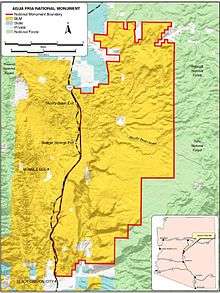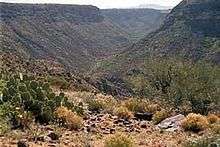Agua Fria National Monument
Agua Fria National Monument is in Arizona, United States.

Understand
Agua Fria National Monument protects the four prehistoric settlements and over 450 other prehistoric sites of the Pueblo people that lived here between 1250 and 1450 AD. In addition to cultural resources, the Monument also protects the natural environment of the Agua Fria River and its tributaries.
The Monument is not developed and many of the roads in the area require high-clearance vehicles with 4x4 capability. There are no facilities in the Monument.
Fire and smoking restrictions are in effect within the Monument's borders. There is no:
- Building, maintaining, attending, or using a fire, campfire, charcoal, coal, or wood stove other than an agency provided ring or grill within developed campsite or picnic area listed in the order.
- Smoking, except within an enclosed vehicle or building, a developed recreation site/improved site or while stopped in an area at least 10 feet in diameter that is barren or cleared of all flammable materials.
History
Landscape
The monument is semi-desert grassland, cut by ribbons of valuable riparian forest along waterways. The elevation of the monument ranges from 2,000 to 4,000 feet (610-1220 m).
Flora and fauna
Several sensitive wildlife species inhabit the Monument: the lowland leopard frog, the Mexican garter snake, the common black hawk, and the desert tortoise.
Less endangered species in the area include pronghorn, mule deer, and white-tail deer. Javelina, mountain lions, small mammals, reptiles, amphibians, fish, and neotropical migratory birds also inhabit the area. Elk and black bear are present, but less abundant.
The waterways in the Monument are home to the longfin dace, the Gila mountain sucker, the Gila chub, and the speckled dace, all native to the region.
Climate
Get in

The Agua Fria National Monument is located 40 miles (64 km) north of Phoenix, AZ. Take Interstate 17 to the Badger Springs (Exit #256), Bloody Basin Road (Exit #259), or Cordes Junction exits.
Fees and permits
Admission to Agua Fria is free but permits are required for groups of more than 25 persons or for guides leading groups into the Monument.
Get around
There is no public transit in the Monument so visitors must either hike, drive their own vehicles, or ride on horseback to get around.
See
- Pueblo La Plata (A four-wheel drive vehicle is needed to reach the site. Take I-17 to the Bloody Basin Road (exit #259). Turn right off the exit ramp onto Bloody Basin Road which soon crosses a cattle guard and becomes well graded dirt before reaching a kiosk (stop and pick up a map). To go to Pueblo la Plata, drive 8.3 miles (13.4 km) to an unmarked dirt road on the left (north). You can identify this road by the earthen cow tanks a short distance down it. Turn left on this road which is suitable only for high clearance vehicles, though even then you may want to park and walk the final 0.5 mile (0.8 km), which is rather rough. Follow the main track staying right and the first branch, left at the second, and left at the third. The road ends at a parking area with a walk through gate.). Pueblo La Plata is the most accessible prehistoric site in the Monument. At one time, this was a village consisting of 80 to 90 rooms inside a massive stonewalled building.
Do

- Viewing cultural sites
- Wildlife viewing
- Birdwatching
- Hiking
- Badger Springs Trail (Off Interstate 17, take exit #256, Badger Springs. Follow the rough, sometimes muddy, gravel road for approximately one mile east to the trailhead parking area.). The trail leads down the Badger Springs Wash to the Agua Fria River canyon, an area rich in archaeological resources. The confluence of Badger Springs and the Agua Fria is the location of a fantastic panel of petroglyphs. At the confluence, hikers can travel either upstream or downstream to explore this high desert canyon. Most years the river flows through early summer.
- Hunting (big-game and upland game-bird) - purchase the appropriate Arizona Game and Fish Department license and permit and follow all federal and state regulations.
- Scenic drives
- Four-wheel driving (off-road travel is not allowed)
Sleep
Lodging
There is no lodging in the Monument. Motels are located in the adjacent communities of Black Canyon City and Cordes Lakes.
Camping
Camping is allowed in undeveloped areas for up to fourteen days. Campers must not dispose of any refuse, hazardous materials, sewage, or gray water, in the surrounding area. All waste must be packed out.
Backcountry
Stay safe
Report crimes to resources including vandalism, dumping, and suspicious activity toll free to +1-800-637-9152.
The nearest medical facility is John C. Lincoln Deer Valley Hospital in north Phoenix (+1 623 879-5351; 19829 N. 27th Ave.) Be prepared to handle minor first aid issues on your own. As there are no facilities in the park, visitors must bring their own water, especially during the summer when the temperature can be higher than 110° F (43° C).
Warm weather will bring rattlesnakes out of their burrows so be cautious when stepping over objects.
Flash floods can occur in washes and river beds, even if it is not raining in the immediate vicinity. If regional weather reports include rain predictions, use caution when entering washes.
Fill your gas tank and be sure your vehicle is in good repair before entering the Monument as it may not be regularly patrolled.
Go next
- Montezuma Castle National Monument
- Tuzigoot National Monument
| Routes through Agua Fria National Monument |
| Flagstaff ← Camp Verde ← Jct N |
N |
→ Anthem → Phoenix |